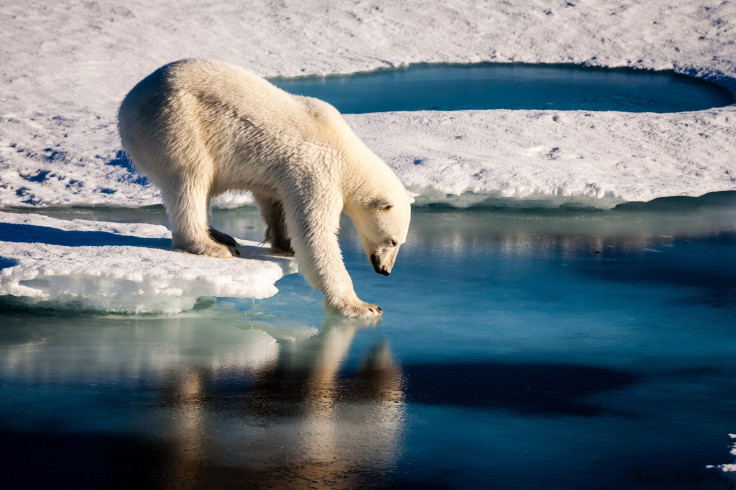Dozens Of Polar Bears Feast On Whale Carcass In Unusual Group Behavior

As climate change continues to cause a reduction in Arctic sea ice and overall ice cover in the polar region, the already threatened polar bears are beginning to display highly unusual behavior. Largely solitary animals in their adult life, dozens of them were seen together recently on an island in northeast Russia.
A tourist boat passing by Wrangel Island, off the coast of Chukotka in Russia’s Far East, saw over 200 polar bears on a mountain slope on the island. Dozens of the animals were seen at the bottom of the slope, eating the carcass of a bowhead whale that had washed ashore. The incident took place in September, but wasn’t widely reported at the time.
Alexander Gruzdev, director of the Wrangel Island nature reserve, who was on the boat named Akademik Shokalskiy, told Agence-France Presse (AFP): “It was a completely unique situation. We were all gobsmacked, to be honest.”
Polar bears, which are close relatives of the brown bear, need access to sea ice to be able to hunt their primary source of food, ringed and bearded seals. Sea ice is also where they spend most of their time, and when it completely melts during the summer, they are forced to spend time on land. Therefore, the loss of Arctic sea ice is the biggest threat these animals face.
The International Union for Conservation of Nature lists polar bears as vulnerable in its Red List of Threatened Species.
“Polar Bears that have continuous access to sea ice are able to hunt throughout the year. However, in those areas where the sea ice melts completely each summer, Polar Bears are forced to spend several months on land, where they primarily fast on stored fat reserves until freeze-up. Use of land by Polar Bears during the ice-free season appears to be increasing at least in some areas where sea ice duration has declined,” according to the Red List.
Wrangel Island is one of those places that polar bears come to during the Arctic summer, and the animals are frequently seen there between early-August and November, before leaving to hunt for seals again. But such a large congregation — estimated to be about 230 individuals, including cubs — is previously unheard of.
This is likely a result of longer periods with little or no sea ice for the bears to move to. Being forced to spend time on land means the usually solitary animals will come into increasing contact with each other, possibly leading to conflict over limited resources.
“They are resourceful and adaptable animals, and some bears will probably find something to eat, but the number of bears we currently have in the Arctic definitely cannot be sustained on land. There is evidence that it foreshadows the future: larger numbers spending more time on the island and ultimately less time on the sea ice with fewer prey, with a negative cascade of effects,” Eric Regehr from the University of Washington, the lead American scientist on the US-Russian collaborative study of Wrangel Island polar bears, told AFP.
As polar bears spend more time on land, it could also create more problematic situations in human habitations in the circumpolar regions, with more instances of human-animal conflict.
© Copyright IBTimes 2025. All rights reserved.





















